Everything You Need To Know About Trichomes
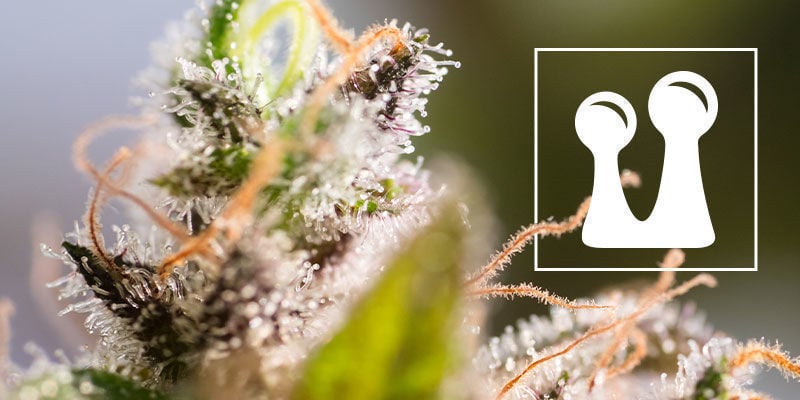
You've likely heard of trichomes before, but most people have no idea what they do. Despite their low public profile, trichomes contain the most important compounds in marijuana plants. Here's the full rundown on cannabis trichomes.
If you've ever done any research on marijuana, we bet you've come across the term "trichome" before. While it sounds like one of the many chemical compounds in cannabis, such as cannabinoids, flavonoids, and terpenes, trichomes are actually their source!
Performing key tasks throughout a cannabis plant’s life, trichomes are also a vital factor in determining the quality of any strain. But before you go out and look for the strain with the "best trichomes", you should learn about different types of trichomes and their exact role regarding cannabis. Let’s dive in!
What are trichomes?
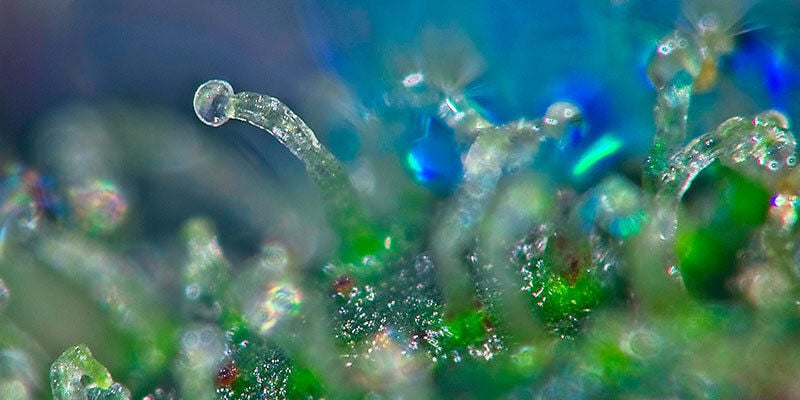
If you're looking at a mature weed plant, trichomes are the tiny, white, hair-like growths sticking out of the buds and sugar leaves. Interestingly, the word comes from the Greek term “tríchōma”, which simply means "growth of hair". Cannabis trichomes are very small; less than 1 millimetre long, hardly visible to the naked eye.
From a distance, though, trichomes appear like a layer of frost over the flowers. Ever heard someone equate “THC crystals” or resin to harder-hitting weed? What they’re referring to here, whether they know it or not, is an abundance of trichomes. These little hairs, subtle as they are, hold a much higher concentration of cannabinoids, flavonoids, and terpenes than any other part of the plant. In short: more trichomes equals more potency.
And while we've only been talking about cannabis, trichomes happen to exist on many other plants, including tomato, basil, mint, and stinging nettle. The little white hairs full of venom on nettles; these are trichomes. So it’s not all good! They all look different and serve different purposes, but they're all trichomes. To prevent any confusion, we'll only be discussing them in the context of cannabis.
But in general, trichomes are glands that grow on the surface of plants in which various, useful compounds are produced.
What are trichomes for?
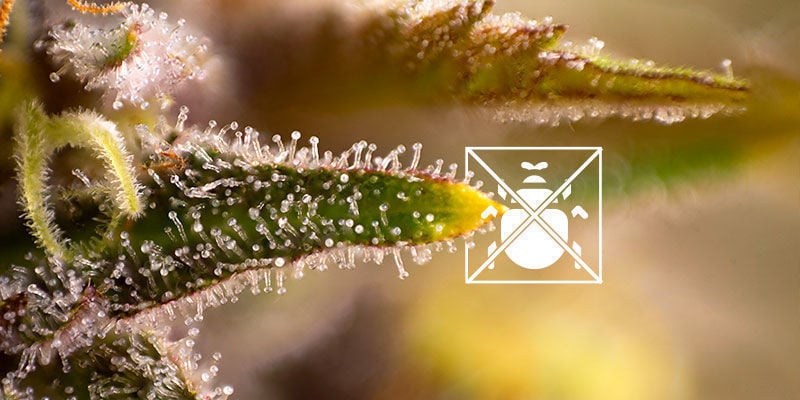
Trichomes serve many purposes for cannabis plants. They help to deter predators, protect against UV rays from the sun, trap harmful insects, create useful metabolites, and more. Below, we will explain some of the uses that trichomes are put to by flowering cannabis plants.
Trichomes for protection against non-living elements
During the flowering stage, female cannabis plants become fragile in the face of the elements. Factors such as heat, UV light, and wind all pose a threat to an unprotected plant. Thanks to the trichomes, though, they're safe from all these factors. They cover enough of the plant's surface area to keep it cool, and fend off harmful UV rays. Simultaneously, they serve as a protective layer against winds that could damage the integrity of the plant (Wang et al., 2021).
Trichomes for protection against animals and pests
The potent scents and aromas of trichomes may be a draw to human cannabis users, but they’re very off-putting to potential predators. If you doubt this, put a fresh bud in your mouth and chew it—see how it tastes. Chances are, you won’t be making this a staple part of your diet.
Trichomes serve to ward off would-be predators (Stack, 2023). Not only do they do this by tasting awful, but their resinous stickiness even works like a glue trap for smaller insects that can trap and kill them.
Types of trichomes
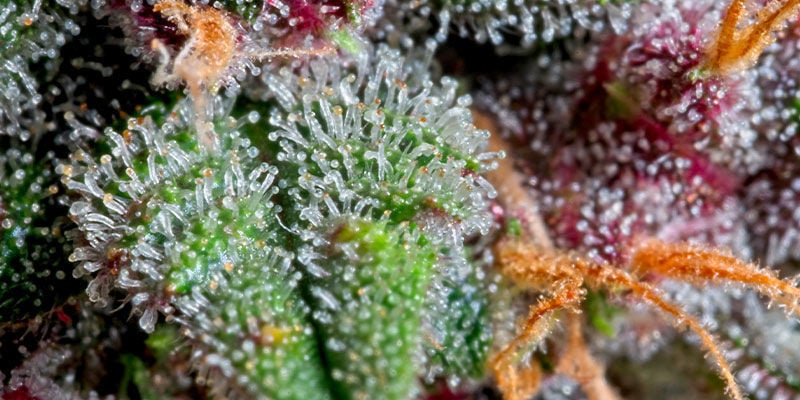
We haven't made distinctions thus far, but there are many different types of trichomes. Some are more common on cannabis plants than others, but they all play an important role. First, we have to form a distinction between glandular and non-glandular trichomes.
Glandular trichomes
In short, glandular trichomes are ones that secrete substances inside their "head", aka their gland. There are three main kinds of these present on cannabis plants.
Capitate-stalked trichomes
Measuring between 50–100 micrometres (one micrometre is one-thousandth of a millimetre) wide, capitate-stalked trichomes are the largest of the three. In fact, these are the ones you'll usually notice when looking at some high-quality bud. As the name suggests, this type boast a relatively large stalk, upon which rests a sizeable cannabinoid and terpene-rich gland.
Capitate-sessile trichomes
These are smaller than their fellow capitate trichomes, but important nonetheless. They grow to 20–30 micrometres wide, and they, like the aforementioned trichome, have a stalk. It's much shorter, though, and the gland contains proportionally fewer compounds in turn.
Bulbous trichomes
Lastly, despite the name, bulbous trichomes are essentially microscopic at 10–15 micrometres wide. They don't have a stalk like the others, but sit directly on the surface of the plant. Their small size also means that, while they contain the same type of compounds as the others, they have minimal capacity for storing those compounds.
Non-glandular trichomes
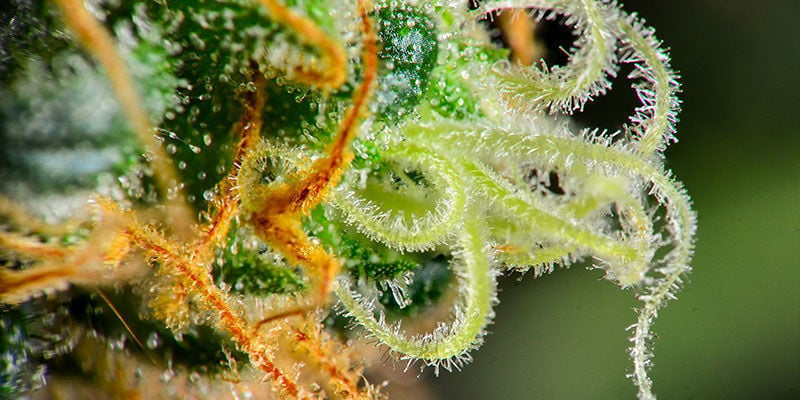
These trichomes, as you might suspect, are distinguished by their lack of gland. This means they don't contain the cannabinoids and other compounds we love trichomes for. They still serve various uses, though, and shouldn't be ignored entirely.
There are three varieties of this type.
Unicellular trichomes
Unicellular trichomes serve to protect the plant from extreme temperatures and water loss. They start out covering the seedling, later appearing on the undersides of the leaves of the maturing plant. As their name suggests, they're single-celled and can't be seen without a microscope. Look closely, though, and you'll notice similarities to short hairs.
Cystolithic trichomes
Cystolithic trichomes also appear early on in a cannabis plant's life. They look similar to their unicellular peers mentioned above, except they're larger and have a special outgrowth on their cell walls. This leaves them rough to the touch, a little like needles. It's suspected they protect the young plant from predators such as mammals with sensitive tongues.
Antherial sessile trichomes
Lastly, antherial sessile trichomes are only found on the anthers and surrounding calyx of cannabis plants. They're about 80 micrometres wide, making them the largest of the sessile trichomes. The ones found on the calyx, however, are a bit smaller than the ones on the anthers.
The trichome life cycle
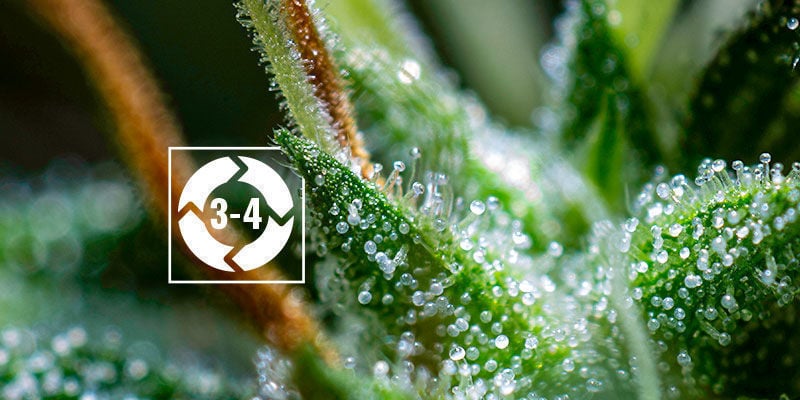
Like the plant they grow on, trichomes have their own development process. It syncs up with the cannabis growth process, with the first real changes occurring 3–4 weeks into the flowering stage. From there, you have to pay attention to figure out when exactly to harvest your plant for maximum potency. We recommend using a jeweller's loupe or micro lens that can zoom in about 120x to observe your developing trichomes.
Determining harvest time
As harvest time approaches, you'll see the trichomes in one of three hues: clear, cloudy, or amber.
If they're clear, it simply means the plant isn't yet ready for harvest. It's still producing resin to push into the glands, and the glands are not yet filled. In turn, if you were to harvest at this point, you wouldn't feel much from smoking it.
Once they become cloudy-white, though, they've hit peak resin capacity. If you're looking for a strong head high after smoking the buds, this is your optimal harvest time. Those growing sativas should make sure they don't wait much longer. It doesn't mean the strain is inherently strong, but it means it's now as potent as it can be.
That stage will pass, though, and the trichomes will turn from cloudy to amber. If you're growing an indica, this would be the best time for you to harvest. Amber trichomes indicate the high will be more relaxing and sleepy than uplifting and stimulating. However, it also indicates that the THC levels have begun to decline. If you desire this type of effect, wait until about 50% of the trichomes have turned amber (mixed).
As a side note: before you even start, you can take certain steps to maximise how many trichomes are there in the first place.
Isolating trichomes
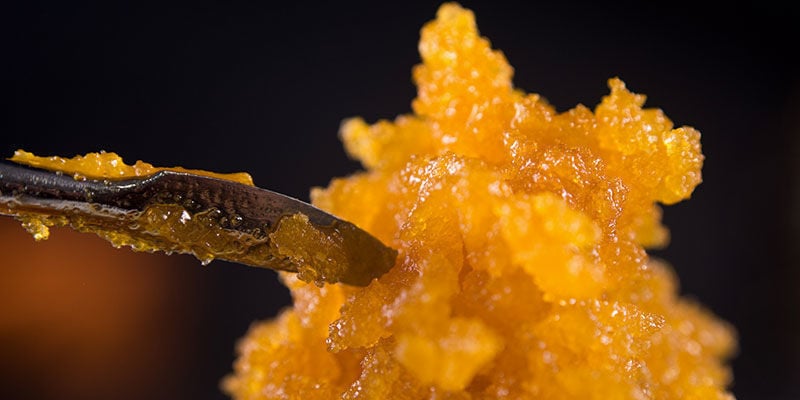
Since they contain all the resin we love cannabis for, you might want to figure out how to isolate trichomes from the rest of the plant to make hash, kief, extracts or concentrates. Thankfully, you've got a few options if you want to unlock this next level of high.
Mechanically (with a grinder)
Now, you might be thinking, "Wait, you mean that type of grinder?". Yes; if you have a three-chamber grinder, you already know how to mechanically isolate trichomes! Just throw your weed in there, grind it up, and check the bottom tier for your prize. "But that's just kief!". Exactly, dear reader! Kief is an accumulation of trichomes in powder form. You won't get 100% of what's on your bud, but it's still a sizeable amount.
Solvent-based extraction
If you want to get closer to harnessing all the trichomes, you could try solvent-based extraction.
To do this, pressurised butane gas can be used to separate cannabis plant matter from its trichomes. This process, given the very explosive nature of the butane gas, isn't normally safe to do at home. However, many of the concentrates on the legal marijuana market are created using this method. Even with the potential safety risks, it's the cheapest effective method out there, and is only dangerous when conducted by an amateur. If you don't want to use butane, pure alcohol should also do the trick. We also have some nifty devices in our online store that can simplify the process.
Solventless extraction
Lastly, solventless extraction is the safest and probably easiest method available. To do this at home, just add your cannabis to some ice water, and shake it up to begin the trichome separation. The process is rather detailed, so we recommend checking out our full guide to making bubble hash if you're looking to try it.
But in short, ice cold water helps to separate trichomes from cannabis flower. So first, you need to agitate flowers in very cold water. Then, strain the water through a fine mesh, such as a coffee filter. Once this coffee filter dries, you should find pure trichomes left over, which can be pressed into hash and then smoked or vaped.
Bubble hash is essential very pure hash, as it leaves most of the excess plant matter behind.
Harness trichomes when they are at their best!
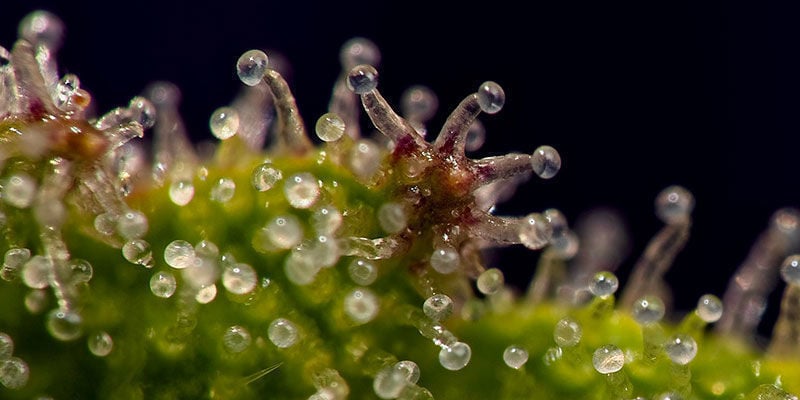
Even if you never knew what trichomes were before now, the chances are that if you love weed, you’ve been loving trichomes all along without even knowing it. Well, now you know where to direct your love.
If you want, you can simply continue smoking bud and appreciating the glands growing all over it. Just pick up a magnifying glass and look at those beauties. Or, you can take these trichomes and make concentrates, further improving your cannabis experience. The Zamnesia store contains a whole host of helpful equipment if you’re interested!














 United States
United States










